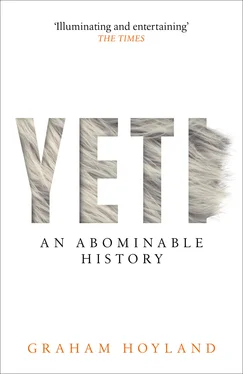Later, he expanded the story: he reported that the party (including Mallory, who also saw the tracks) was camped at 20,000 feet and set off at 4am in bright moonlight to make their crossing of the pass. On the way, they saw the footprints, which ‘were probably caused by a large loping grey wolf, which in the soft snow formed double tracks rather like those of a bare-footed man’. However, the porters ‘at once volunteered that the tracks must be that of “The Wild Man of the Snows”, to which they gave the name metoh kangmi ’.
Howard-Bury himself did not believe these stories. He had sent a newspaper article home by telegraph, and, as Bill Tilman so delightfully put it in his famous yeti Appendix B to Mount Everest 1938 : ‘In order to dissociate himself from such an extravagant and laughable belief he put no less than three exclamation marks after the statement (the Wild Men of the Snows!!!); but the telegraph system makes no allowance for subtleties and the finer points of literature, the savings sign were omitted, and the news was accorded very full value at home.’ 4
The Times of London ran the story under the lurid headline of ‘Tibetan Tales of Hairy Murderers’. As a result, a journalist for The Statesman in Calcutta, Henry Newman, who wrote under the telling pseudonym ‘Kim’, interviewed the porters on their return to Darjeeling. It is rare that you can spot the actual beginning of a legend, but here is the moment of birth of the Western yeti:
I fell into conversation with some of the porters, and to my surprise and delight another Tibetan who was present gave me a full description of the wild men, how their feet were turned backwards to enable them to climb easily and how their hair was so long and matted that, when going downhill, it fell over their eyes … When I asked him what name was applied to these men, he said ‘ metoh kangmi ’: kangmi means ‘snow men’ and the word ‘metoh’ I translated as ‘abominable’.
This was a mis-translation. Howard-Bury had already offered ‘man-bear’ as the translation. Later we will see that what ‘another Tibetan’ probably said was meh-teh, which was a fabled creature familiar to any Sherpa or Tibetan who had heard the stories on his mother’s knee, or who had looked up at the frescoes in a Buddhist monastery. What the porters were describing was perfectly familiar to them in their own terms: ‘man-bear’. Tilman recounted in his Appendix B how Newman wrote a letter long afterwards in The Times , a paper with a long and profitable relationship with the Abominable Snowman and Mount Everest. ‘The whole story seemed such a joyous creation, that I sent it to one or two newspapers. Later I was told I had not quite got the force of the word “ metch ”, which did not mean “abominable” quite so much as filthy or disgusting, somebody wearing filthy tattered clothing. The Tibetan word means something like that, but it is much more emphatic, just as a Tibetan is more dirty than anyone else.’
In fact, Newman, Tilman or his publisher had got the spelling wrong: the letters TCH cannot be rendered in Tibetan, and what Newman probably should have written was ‘metoh’, meaning man-bear and certainly not ‘abominable’. The word that the Sherpas use to refer to the creature is actually yeh-teh , or yeti, which is perhaps a corruption of meh-teh , again ‘man-bear’.
It may seem that I am making a meal of this, but whether by accident or by design Newman had ‘improved’ the story to invent a name that was not a true translation of what the porters had actually said, but instead was destined to send a frisson of horror through The Times readers of the Home Counties. This was such a powerful new myth that it may have helped the eventual climbing of Mount Everest.
Newman had gleaned the fascinating fact that the wild men had their feet turned backwards to enable them to climb easily, which is an odd detail as climbers in those pre-war days used to reverse up very steep ice slopes when wearing their flexible crampons. Newman’s pseudonym ‘Kim’ suggests that he was an admirer of Rudyard Kipling’s character, the boy-spy, and so the Western yeti also began his long and peculiar association with the intelligence services, eventually reaching as far as MI5 and the CIA. As for Newman’s exaggeration of the name Abominable Snowman, perhaps he was gilding a dog’s ear, but whatever his reason the name stuck.
Thus began the long-running Western legend of the Abominable Snowman/yeti. And all because of the absence of three exclamation marks!!! Another newspaper picked up the first report and embellished it in January 1922, claiming that Howard-Bury’s party had discovered ‘a race of wild men living among the perpetual snows’. There was a quote from one William Hugh Knight, who the writer claimed was ‘one of the best known explorers of Tibet’, and a member of ‘the British Royal Societies club’ who said that he had ‘seen one of the wild men from a fairly close distance sometime previously; he hadn’t reported it before, but felt that due to the statement about manlike footprints that was made by Howard-Bury’s party, he was now compelled to add his own evidence to the growing pile’.
Knight said that the wild man was ‘… a little under six feet high, almost stark naked in that bitter cold: it was the month of November. He was kind of pale yellow all over, about the colour of a Chinaman, a shock of matted hair on his head, little hair on his face, highly-splayed feet, and large, formidable hands. His muscular development in the arms, thighs, legs, back, and chest was terrific. He had in his hand what seemed to be some form of primitive bow.’ The article went on to claim that the porters had seen the creatures moving around on the snow slopes above them.
The only problem is that William Hugh Knight wasn’t one of the best-known explorers of Tibet, and the British Royal Societies club didn’t exist. However, there was a Captain William Henry Knight, who had obtained six months’ leave to explore Kashmir and Ladakh over sixty years earlier, in 1860, and wrote the Diary of a Pedestrian in Cashmere and Thibet , 5but nothing in his book resembles the reported description. It would seem that the journalist had plucked the name of a long-dead real Tibetan explorer, changed the name slightly, invented an explorer’s club and made up the quote. 6This was indeed part of a growing pile: a pile of lies. Incidentally, note that at this stage the wild man is recognisably human: he is partly clothed, he has little hair on his face and he carries a bow. It is only later that he becomes more like the furry ape of legend.
Howard-Bury was well aware of the sensation his report had caused. In his book about the expedition, Mount Everest: The Reconnaissance, 1921, he wrote: ‘We were able to pick out tracks of hares and foxes, but one that at first looked like a human foot puzzled us considerably. Our coolies at once jumped to the conclusion that this must be “The Wild Man of the Snows”, to which they gave the name of metoh kangmi , “the abominable snowman” who interested the newspapers so much. On my return to civilised countries I read with interest delightful accounts of the ways and customs of this wild man who we were supposed to have met.’ 7
What was needed now, of course, was a sighting, and so along it came. In 1925 the British-Greek photographer N. A. Tombazi was on a British Geological Expedition near the Zemu glacier, when he spotted a yeti-like figure between 200 and 300 yards away. He reported: ‘Unquestionably, the figure in outline was exactly like a human being, walking upright and stopping occasionally to uproot or pull at some dwarf rhododendron bushes. It showed up dark against the snow and as far as I could make out, wore no clothes. Within the next minute or so it had moved into some thick scrub and was lost to view.’
Читать дальше











